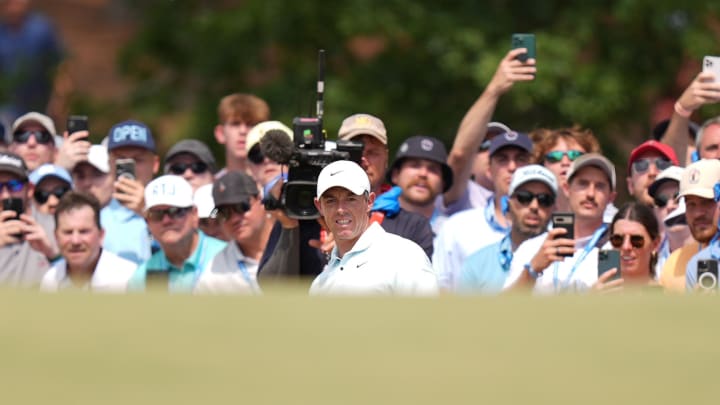The Greens of Pinehurst No. 2 Decided the U.S. Open Won By Bryson and Lost By Rory

Before the start of the 2014 U.S. Open at Pinehurst No. 2, Ben Crenshaw told me something about greens after his restoration of the Donald Ross gem with Bill Coore. "Greens should receive greater attention than any other aspect of the design because they are the final act,” he said. “Greens should dictate the play back to the tee box. That's what makes it a strategic effort."
Sunday evening, as the leaders played their final round of the 124th U.S. Open at Pinehurst No. 2, I was brought back to Gentle Ben’s eloquent words about the final act. For me it conjured images of Shakespeare’s Globe Theater in London, with Bryson DeChambeau and Rory McIlroy dueling for one of the most coveted prizes in golf, except this final act was staged on turtleback greens that some players have called unfair and sadistic.
At the beginning of the week—before he was handcuffed by the green complexes on his way to rounds of 74 and 73 to miss the cut by two shots—Tiger Woods had foreshadowed his fate in his 23rd U.S. Open.
“When Donald Ross did this golf course and made the greens this severe, I don't think he intended it to be running at 13 on the stimpmeter,” Woods said last Tuesday. “They were the speed of fairways. That's one of the differences when we go to most golf courses, is they're very severe, and we're playing under faster conditions. It's more of a test. It's going to be a great test and a great war of attrition this week.”
No matter where you hit your driver—DeChambeau hit only five fairways on Sunday—players had to contend with the green complexes. How receptive would these grainy Ultradwarf Bermuda greens be to approach shots coming in from angles near runoffs that carried balls down slopes as if they were in a fast-moving stream? Accustomed to mostly using their 60-degree wedge around the green, the best players in the world were confounded with choices from trying soft high buttery wedge shots off tight lies to using a 6- or 7-iron for a bump and run to putting. For four days, players trying to use putters off the greens saw their balls get to the crest of the green before losing energy and tumbling back to their feet.
McIlroy will have nightmares about the two missed par putts inside of 4 feet over his last three holes on Sunday, but he also won’t soon forget the bad break he had on the easily reachable par-5 5th hole, which ranked as the easiest hole all four rounds of the championship. The 35-year-old four-time major champion hit his approach into the green and for an instance it looked like he would have a 20-foot eagle putt, but then the ball went straight left and fell off the green down the hill into a sandy waste area from where he would make a bogey. As golfers we want to be rewarded for good shots, but that wasn’t always the case around Pinehurst No. 2’s greens—a reality that will long weigh on McIlroy’s spirits.
McIlroy bolted on Sunday without talking to the media, but his interview after Saturday’s third round offers some clues about his state of mind for most of Sunday afternoon before his collapse in the late evening when ending his 10-year winless streak in the majors was in his grasp.
“I think I'm embracing the questions that the golf course asks of you,” he said. “I think there's holes where you have to be aggressive. There's holes where you have to be conservative. There's hole locations that you can take on and hit wedges close to. There's hole locations you've got to stay away from.”
No one mastered the green complexes at Pinehurst No. 2, but DeChambeau played them well when it mattered the most. Even as a wildly left-brained mechanical mad scientist with an entourage the size of a prizefighter, the 30-year-old LIV Golf member had to concede that these green complexes took more imagination and creativity than he could control with his machinelike approach to the game.
“In certain situations where I have no control over what's going to happen, you got to just figure out how to will it and get it done,” he said on Sunday night. “That creativity gets sparked. When the greens are not perfectly flat, they're not glass, there's some little bumps and whatnot, being imaginative, seeing how the ball is going to curve over the edge, really getting into it in your mind is what I focus on. So there is a bit of creativity in me, even though I try to be mechanical.”
For most of his final round, DeChambeau didn’t let the greens dictate what he would hit off the tee. He drove the ball wildly and as far as he could. But when he got to the final act on the 72nd hole on Sunday evening, he made a little 3-footer after a masterful 55-yard bunker shot to seal the deal for his second U.S. Open. The 2024 U.S. Open may long be remembered for McIlroy’s collapse at the end and for DeChambeau’s resurgence to the top of major championship golf, but those green complexes were scene-stealers on many occasions during the week by standing up to the best players in the world.
